Glaciers
Without doubt, the most impressive things I saw on my recent trip to Alaska were the glaciers.
Prior to this, I had never seen one, at least not in person. I have a few old pictures of my uncle visiting a glacier when took a motorcycle tour of Banff and Jasper National Parks in the late 1940's. It looked pretty frosty. When I finally saw one for myself, pictures could not describe the impression it left on me.

Coming into Alaska on Highway 1, I passed a number of spectacular mountain peaks as the highway slowly rose in elevation and leveled off. Roughly 50 miles from Palmer, the grade began to descend. On my way down I caught sight of a curious feature.
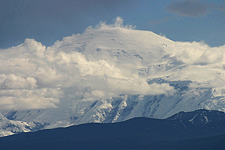
Along the side of a mountain range was a river of ice. The scene looked as though someone had spilt some milk and it was following the path of least resistance. It hardly appeared substantial at all. From a distant side view, the phenomenon came across like a white ribbon that curved its way back between the peaks.
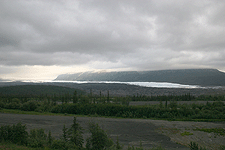
Then a sense of scale set in. I was observing a mountain. A huge one. The snowy band at its base must be tens of miles in length, with significant width and depth. It had to be. This was my first glacier and it was glorious.
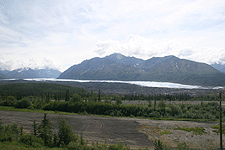
Continuing my drive, I eventually came to a scenic turnoff that included a viewing platform. I was still at a great distance, but had now passed the end of the field. Reoriented, the glacier was flowing towards me. I took out my camera and attached the telephoto lens. The terminus of the ice sheet looked very peculiar. The surface gave the appearance a tooth. Its irregular edge undulated like a crashing wave at the beach. The body behind rippled into the vast distance beyond. This was the Matanuska Glacier.
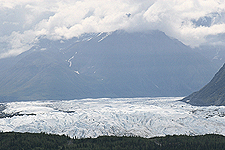
I only had a couple of minutes to take in this natural wonder, then it was off again to Palmer. During my assignment, the builder I was shooting for advised me to visit the Portage Glacier if I found 2 or 3 hours to kill. On Sunday, that is just what I did. Driving South, through Anchorage, I skirted the edge of the Kenai Peninsula and Cook Inlet until I reached Chugach State Park. A sign pointed the way to the Portage Glacier and there I went.

Having never seen the Portage Glacier, I was unsure of what to be on the lookout for. In the distance, nestled between two crests was a formidible sheet of descending ice. Surely that must be it. I got as close as I could and pulled into a parking lot next to an observation area. The scene was quite beautiful. A craggy cake of turquoise ice was perched between two rocky peaks. White clouds flowed over and into the depression, caressing the ice as it went by. Framing this was a vivid blue sky, green babbling brook and hearty evergreens as far as the eye could see.
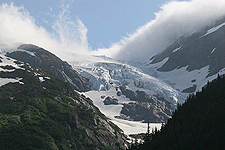
Somehow, though, the scene did not seem worth all the buildup. Yes, it was pretty, but there was an awfully lot of snow residing between the mountaintops most everywhere. I didn't see what might make this an exception. Just in case, I got in the car and drove further down the road. Then I came to a sign saying "Portage Glacier Ahead". Well, I felt kind of silly after taking so many pictures of something else, but was glad to have finally stumbled across the genuine article.

The road deposited me into a parking lot in front of a small lake. Floating tranquilly were two aqua-colored icebergs each the size of a truck. Off in the overcast distance was a massive bed of grey ice, creeping towards the water's edge. It had the character of something that had been around for a very long time. It was cracked and dingy. Spectators were gathering at the lip of the lake to have their images taken with the glacier in the background. Here, the air was actually cold. Not only did people need sweatshirts, but jackets as well. Someone in the group informed me that this body of ice, like many others, was receding. It had been much more prominent in the past. This was not too difficult to spot.
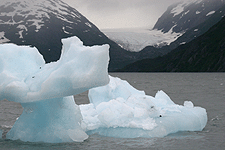
It would have been nice to have gotten closer to this frozen giant, but that would have required one of the available boat tours, for which I did not have the time. Therefore, it was back to Palmer. The next day, I finished my work and was ready to depart. Forced to exit Alaska the same way I entered, I was presented with one last opportunity to experience Matanuska.
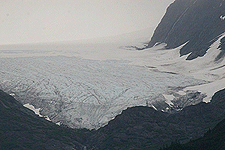
The Matanuska glacier does have public access. Tailing a happy couple in a car to the gate, I signed the safety waiver and followed them to the staging area. As one would guess, walking on a glacier can be pretty hazardous. Any number of bad, unexpected things can occur. This did not stop a moderate contingent of inquisitive souls from taking a stroll on the ice.
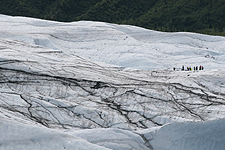
It took about 15 minutes to walk from the parking lot to the leading edge of the ice. During this process, one learns a few fascinating things about glaciers. First, park managers set up a path for explorers to follow using orange safety cones. Even though you can see the land between yourself and the glacier rather clearly, this precaution is to keep you from getting stuck in the dense grey mud.
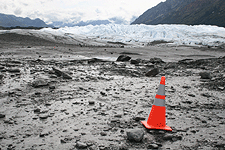
Following the trail, the ground is a bit rough, but nothing a normal person couldn't handle. As you progress you notice that the ground does indeed get soggy. This is from all the liquid runoff the melting glacier is producing, or perhaps the surrounding snow. In either case, little streams of water were flowing in numerous places.
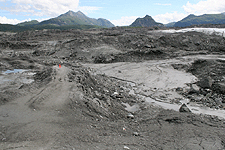
Before long I noticed a transition in the ground's texture. I looked down to see a collection of small angular rocks imbedded in solid blue ice. It was extremely hard, dense and heavy. Not so much like metal, which has a degree of flexibility, but more like acrylic or crystal.
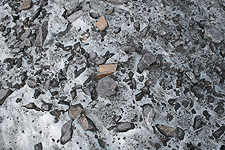
Next came the sound of a light crunching as I moved on to the snow. Like the crackling sound a bowl of cereal makes when you crush the flakes with a spoon. I could feel the surface mash down just a little when I walked on it. Also, the temperature began to get cold. Whereas I was warm before, I now needed a sweatshirt to be comfortable.

Eventually I reached the bounding heaps of ice. These got progressively larger as the glacier moved on into the distance. Traversing the ice sheet, for me, was problematic. I was wearing tennis shoes. Other visitors, who had brought shoe cleats and ice picks were nimbly hiking the major masses of the pack. I was only going to be able to get so far. The trick was to stay on the dirty areas, where tiny pebbles were stuck in the snow. These could be walked on. Finding a direct path of them from point A to point B was not necessarily easy.
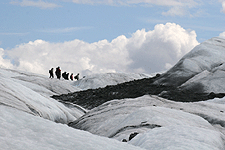
With extreme caution, I climbed onto the lesser domes of the ice. In the valleys, lengthy fractures had formed and these had water flowing through them. Since I was forced to walk in the low areas, getting wet or muddy was always a potential difficulty. At one point, I found a flat area of dirt and rocks that seemed favorable. This turned out to be mostly mud with a slightly dry surface. Glop, glop I went.
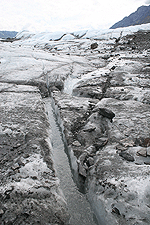
Ultimately, I topped the crest of one of the minor mounds and stopped to survey the enormous body of the glacier that spread out before me. I knew I would not be able to go further, up ahead where many other tourists were marching. For me, this was good enough. I was standing on a glacier and it was totally thrilling, more so than any other place I had been.

How can I describe what I saw? It was spectacular. It was big. it was white. it was lumpy. It was powerful. It was serene. It had cracks criss-crossing it. Clusters of chilly people were wandering all over it. It was like an ice maker dumped out several trillion ice cubes in a very long pile. You were dwarfed by it, like an insect is dwarfed by a freeway. It's just hard to believe that it even exists and that you are touching it. It was beautiful. It makes your heart race.
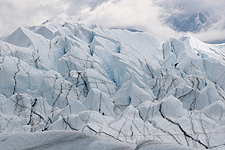
Continuing down the other side of the slippery slope, I discovered a dry, rocky area that circled back to the glacier's edge. I should point out that around the leading edge of the glacier, sharp-edged rocks of all sizes could be found just setting there. Most of them looked as though they had been shattered, no doubt by the tremendous pressure they encountered in the ice during their long journey to this place.
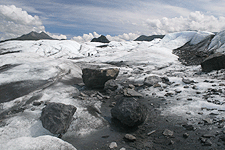
Heading back to the car, a revelation occured to me. As I left the swollen heaps of shiny white ice and navigated the frozen, blue, rock-saturated ground, I realized that I was still on the glacier. It did not simply begin where the lumpy mounds appeared. It was deep beneath my feet. Here, the top frosty layer had been melted away, leaving the rest to be covered over by dirt. Who knows how far beyond the visible edge the glacier actually extended. This is what a glacier goes through in recession.

It was sad to say goodbye to the Matanuska Glacier, I wish I could have stayed longer to explore. My brief encounter was both exhilarating and informative. I hope I have the chance to see another. I hope you do too.
Prior to this, I had never seen one, at least not in person. I have a few old pictures of my uncle visiting a glacier when took a motorcycle tour of Banff and Jasper National Parks in the late 1940's. It looked pretty frosty. When I finally saw one for myself, pictures could not describe the impression it left on me.

Coming into Alaska on Highway 1, I passed a number of spectacular mountain peaks as the highway slowly rose in elevation and leveled off. Roughly 50 miles from Palmer, the grade began to descend. On my way down I caught sight of a curious feature.

Along the side of a mountain range was a river of ice. The scene looked as though someone had spilt some milk and it was following the path of least resistance. It hardly appeared substantial at all. From a distant side view, the phenomenon came across like a white ribbon that curved its way back between the peaks.

Then a sense of scale set in. I was observing a mountain. A huge one. The snowy band at its base must be tens of miles in length, with significant width and depth. It had to be. This was my first glacier and it was glorious.

Continuing my drive, I eventually came to a scenic turnoff that included a viewing platform. I was still at a great distance, but had now passed the end of the field. Reoriented, the glacier was flowing towards me. I took out my camera and attached the telephoto lens. The terminus of the ice sheet looked very peculiar. The surface gave the appearance a tooth. Its irregular edge undulated like a crashing wave at the beach. The body behind rippled into the vast distance beyond. This was the Matanuska Glacier.

I only had a couple of minutes to take in this natural wonder, then it was off again to Palmer. During my assignment, the builder I was shooting for advised me to visit the Portage Glacier if I found 2 or 3 hours to kill. On Sunday, that is just what I did. Driving South, through Anchorage, I skirted the edge of the Kenai Peninsula and Cook Inlet until I reached Chugach State Park. A sign pointed the way to the Portage Glacier and there I went.

Having never seen the Portage Glacier, I was unsure of what to be on the lookout for. In the distance, nestled between two crests was a formidible sheet of descending ice. Surely that must be it. I got as close as I could and pulled into a parking lot next to an observation area. The scene was quite beautiful. A craggy cake of turquoise ice was perched between two rocky peaks. White clouds flowed over and into the depression, caressing the ice as it went by. Framing this was a vivid blue sky, green babbling brook and hearty evergreens as far as the eye could see.

Somehow, though, the scene did not seem worth all the buildup. Yes, it was pretty, but there was an awfully lot of snow residing between the mountaintops most everywhere. I didn't see what might make this an exception. Just in case, I got in the car and drove further down the road. Then I came to a sign saying "Portage Glacier Ahead". Well, I felt kind of silly after taking so many pictures of something else, but was glad to have finally stumbled across the genuine article.

The road deposited me into a parking lot in front of a small lake. Floating tranquilly were two aqua-colored icebergs each the size of a truck. Off in the overcast distance was a massive bed of grey ice, creeping towards the water's edge. It had the character of something that had been around for a very long time. It was cracked and dingy. Spectators were gathering at the lip of the lake to have their images taken with the glacier in the background. Here, the air was actually cold. Not only did people need sweatshirts, but jackets as well. Someone in the group informed me that this body of ice, like many others, was receding. It had been much more prominent in the past. This was not too difficult to spot.

It would have been nice to have gotten closer to this frozen giant, but that would have required one of the available boat tours, for which I did not have the time. Therefore, it was back to Palmer. The next day, I finished my work and was ready to depart. Forced to exit Alaska the same way I entered, I was presented with one last opportunity to experience Matanuska.

The Matanuska glacier does have public access. Tailing a happy couple in a car to the gate, I signed the safety waiver and followed them to the staging area. As one would guess, walking on a glacier can be pretty hazardous. Any number of bad, unexpected things can occur. This did not stop a moderate contingent of inquisitive souls from taking a stroll on the ice.

It took about 15 minutes to walk from the parking lot to the leading edge of the ice. During this process, one learns a few fascinating things about glaciers. First, park managers set up a path for explorers to follow using orange safety cones. Even though you can see the land between yourself and the glacier rather clearly, this precaution is to keep you from getting stuck in the dense grey mud.

Following the trail, the ground is a bit rough, but nothing a normal person couldn't handle. As you progress you notice that the ground does indeed get soggy. This is from all the liquid runoff the melting glacier is producing, or perhaps the surrounding snow. In either case, little streams of water were flowing in numerous places.

Before long I noticed a transition in the ground's texture. I looked down to see a collection of small angular rocks imbedded in solid blue ice. It was extremely hard, dense and heavy. Not so much like metal, which has a degree of flexibility, but more like acrylic or crystal.

Next came the sound of a light crunching as I moved on to the snow. Like the crackling sound a bowl of cereal makes when you crush the flakes with a spoon. I could feel the surface mash down just a little when I walked on it. Also, the temperature began to get cold. Whereas I was warm before, I now needed a sweatshirt to be comfortable.

Eventually I reached the bounding heaps of ice. These got progressively larger as the glacier moved on into the distance. Traversing the ice sheet, for me, was problematic. I was wearing tennis shoes. Other visitors, who had brought shoe cleats and ice picks were nimbly hiking the major masses of the pack. I was only going to be able to get so far. The trick was to stay on the dirty areas, where tiny pebbles were stuck in the snow. These could be walked on. Finding a direct path of them from point A to point B was not necessarily easy.

With extreme caution, I climbed onto the lesser domes of the ice. In the valleys, lengthy fractures had formed and these had water flowing through them. Since I was forced to walk in the low areas, getting wet or muddy was always a potential difficulty. At one point, I found a flat area of dirt and rocks that seemed favorable. This turned out to be mostly mud with a slightly dry surface. Glop, glop I went.

Ultimately, I topped the crest of one of the minor mounds and stopped to survey the enormous body of the glacier that spread out before me. I knew I would not be able to go further, up ahead where many other tourists were marching. For me, this was good enough. I was standing on a glacier and it was totally thrilling, more so than any other place I had been.

How can I describe what I saw? It was spectacular. It was big. it was white. it was lumpy. It was powerful. It was serene. It had cracks criss-crossing it. Clusters of chilly people were wandering all over it. It was like an ice maker dumped out several trillion ice cubes in a very long pile. You were dwarfed by it, like an insect is dwarfed by a freeway. It's just hard to believe that it even exists and that you are touching it. It was beautiful. It makes your heart race.

Continuing down the other side of the slippery slope, I discovered a dry, rocky area that circled back to the glacier's edge. I should point out that around the leading edge of the glacier, sharp-edged rocks of all sizes could be found just setting there. Most of them looked as though they had been shattered, no doubt by the tremendous pressure they encountered in the ice during their long journey to this place.

Heading back to the car, a revelation occured to me. As I left the swollen heaps of shiny white ice and navigated the frozen, blue, rock-saturated ground, I realized that I was still on the glacier. It did not simply begin where the lumpy mounds appeared. It was deep beneath my feet. Here, the top frosty layer had been melted away, leaving the rest to be covered over by dirt. Who knows how far beyond the visible edge the glacier actually extended. This is what a glacier goes through in recession.

It was sad to say goodbye to the Matanuska Glacier, I wish I could have stayed longer to explore. My brief encounter was both exhilarating and informative. I hope I have the chance to see another. I hope you do too.


0 Comments:
Post a Comment
<< Home